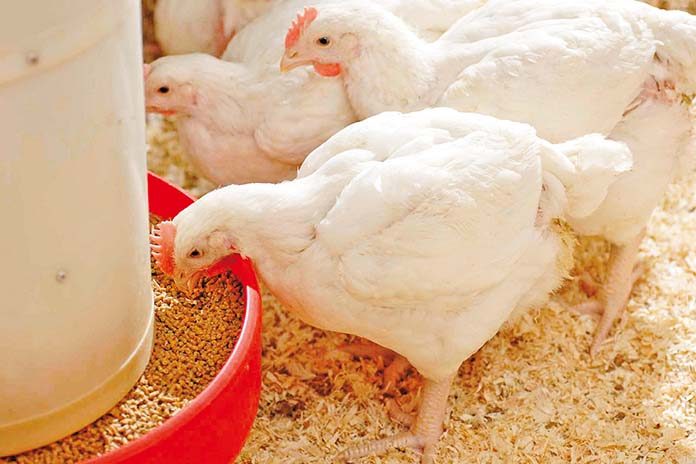
Modern strains of fast-growing broilers have been selected for fast growth, feed efficiency and high feed intake, and broilers are processed once they achieve the desired market body weight typically before six weeks of age.
Broiler breeders are the parent stock of broilers and broiler breeders can remain in production for sixty weeks of age or more. Broiler breeders share the same genetic potential as broilers for fast growth, but also the same predisposition for metabolic disorders under unlimited access to feed intake.
The selection criteria to optimize broilers’ performance is negatively associated with the reproductive performance of broiler breeders. For example, feeding broiler breeders to satiety have negative consequences such as high mortality, poor laying rate, and laid eggs with low hatchability. Obesity-related problems are associated with higher prevalence of premature death, decrease in the reproductive performance (laying rate and persistency, fertility, embryo mortality and chick quality), metabolic disorders and pathologies such as cardiovascular diseases, skeletal problems and excessive adipose tissue. Such consequences of ad libitum feeding have an overall negative impact on the quality of life of broiler breeders, and broiler breeders are feed-restricted through the entire production cycle to avoid obesity-related problems.
A controlled growth rate is achieved by feed restriction throughout the entire productive cycle. Feed restriction in broiler breeders provides nutrients to meet metabolic demands and to support optimal skeletal development, but current commercial feeding strategies for broiler breeders control growth rate by restricting feed allotment up to 45% of ad libitum feed intake (meal size [g]) for the same body weight during rearing. Indeed, broiler breeders often display behavioural and physiological signs of persistent hunger, lack of satiety and feeding frustration at such chronic feed restriction. The experience of such negative affective states raises welfare concerns about broiler breeder management. But, broiler breeders under unlimited access to feed experience health problems that also relate to poor welfare. This trade-off between satisfying feeding motivation and maintaining a healthy body is referred to in the bibliography as ‘the broiler breeder paradox’. For this reason, the disparity between health and behavioural needs has raised welfare concerns since the early 1960s in the poultry meat sector, especially as artificial selection accelerates the growth rate and efficiency of broilers.
The development of feeding strategies has focused on alternative management practice that can control growth rate without the negative consequences of feed restriction. Alternative feeding strategies aim to decrease feeding motivation by increasing feeding intake, feeding duration and reducing voluntary feed intake. Daily quantitative feed restriction is a standard feeding practice for broiler breeders (a small feed intake fed on a daily basis), but alternative feeding strategies include qualitative (rationed or ad libitum) restriction or non-daily quantitative feed restriction. Qualitative restriction refers to dietary caloric dilution with fibrous or bulky ingredients, sometimes in combination with appetite suppressants like calcium propionate. Common ingredients used in alternative diets for broiler breeders includes ingredients with a high proportion of insoluble dietary fibre such as rice hulls, oat hulls and soybean hulls (depending on country, availability, and cost). Quantitative feed restriction limits the access to feed, which may involve altering the number of feeding days per week. Non-daily feeding schedules feed a larger feed allotment on the previous day (on-feed day) followed by an off-feed day. The number of off-feed days per week depends on the feeding schedule. For example, a skip-a-day schedule consists in alternative feeding days every other day, a 4/3 schedule includes four on-feed days with three non-consecutive off-feed days per week, a 5/2 schedule have five on-feed days with two non-consecutive off-feed days per week, and a 6/1 schedule refers to six on-feed days and one off-feed day per week. Off-feed days are not consecutive, and feed delivery does not exceed 48 hours after the last feeding day. The use of non-daily feeding schedules is a common on-farm practice in North America due to the perceived improvement in body weight uniformity. For this reason, non-daily feeding schedules are frequently used when feeding management of broiler breeders achieves the highest feed restriction level especially during mid rearing. Non-daily feeding schedules can start after one month of age up and end before hens are moved to the adult house.
Feeding management of broiler breeders mainly aims to achieve an optimal and profitable reproductive performance by broiler breeders, including hens and roosters. Nevertheless, the feed restriction level that broiler breeders experience during rearing can also negatively impact their reproductive performance because of the chronic stress of feed restriction. Previous research looking at the stress response in broiler breeders noted that broiler breeder pullets show elevated concentration of stress hormones in plasma under commercial feed restriction level and other indicators of poor welfare such as poor feather coverage, high feeding motivation, behavioural signs of hunger, and haematological response. These results indicate that feed restriction for broiler breeder, especially during rearing, is a stressful event probably leading to negative consequences during lay. Although the long-term effect of chronic stress during early-life events on the reproductive performance has not been as well studied yet, results from laying hens have indicated that stressful experiences can compromise (and stop in some cases) laying rate. For this reason, the distress of severe feed restriction can also have negative effect on the reproductive performance during lay in broiler breeder hens.
Feed restriction in broiler breeders is a common practice to achieve a healthy and lean body weight during rearing and an optimal reproductive performance during lay. But the stress experienced due to feed restriction during the development of sexual organs and sexual maturity can negatively impact the reproductive performance of broiler breeders. Thus, the performance of broiler breeder hens is expected to enhance under feeding management that controls growth rate to a health body weight but also that reduces the experience of stress because of the high level of feed restriction.
















